A 3D-Printed Electrochemical Immunosensor Employing Cd/Se ZnS QDs as Labels for the Rapid and Ultrasensitive Detection of Salmonella typhimurium in Poultry Samples
Abstract
:1. Introduction
2. Materials and Methods
2.1. Materials
2.2. Sensor Fabrication
2.3. Biotinylation of Anti-Species Specific Antibody
2.4. Bacteria Culturing and Calibrators Preparation
2.5. Sample Preparation
2.6. Sample Pre-Enrichment
2.7. Electrochemical Immunoassay for Bacteria Detection
3. Results and Discussion
3.1. Assay Optimization
3.2. Assay Time Optimization
3.3. Matrix Effect
3.4. Analytical Characteristics
3.5. Single Bacterium Electrochemical Detection
3.6. Comparison of the Developed Method with Other Electrochemical Sensors
4. Conclusions
Author Contributions
Funding
Institutional Review Board Statement
Informed Consent Statement
Data Availability Statement
Acknowledgments
Conflicts of Interest
References
- Ehuwa, O.; Jaiswal, A.K.; Jaiswal, S. Salmonella, food safety and food handling practices. Foods 2021, 10, 907. [Google Scholar] [CrossRef] [PubMed]
- Shen, Y.; Xu, L.; Li, Y. Biosensors for rapid detection of Salmonella in food: A review. Compr. Rev. Food Sci. Food Saf. 2021, 20, 149–197. [Google Scholar] [CrossRef] [PubMed]
- Salmonella Homepage|CDC. Available online: https://www.cdc.gov/salmonella/ (accessed on 3 July 2023).
- Liu, J.; Jasim, I.; Shen, Z.; Zhao, L.; Dweik, M.; Zhang, S.; Almasri, M. A microfluidic based biosensor for rapid detection of Salmonella in food products. PLoS ONE 2019, 14, e0216873. [Google Scholar] [CrossRef] [PubMed]
- Chicken and Food Poisoning|CDC. Available online: https://www.cdc.gov/foodsafety/chicken.html (accessed on 3 July 2023).
- Silva, N.F.D.; Magalhães, J.M.C.S.; Freire, C.; Delerue-Matos, C. Electrochemical biosensors for Salmonella: State of the art and challenges in food safety assessment. Biosens. Bioelectron. 2018, 99, 667–682. [Google Scholar] [CrossRef] [PubMed]
- Ferone, M.; Gowen, A.; Fanning, S.; Scannell, A.G.M. Microbial detection and identification methods: Bench top assays to omics approaches. Compr. Rev. Food Sci. Food Saf. 2020, 19, 3106–3129. [Google Scholar] [CrossRef] [PubMed]
- Schneid, A.S.; Rodrigues, K.L.; Chemello, D.; Tondo, E.C.; Ayub, M.A.Z.; Aleixo, J.A.G. Evaluation of an indirect ELISA for the detection of Salmonella in chicken meat. Braz. J. Microbiol. 2006, 37, 350–355. [Google Scholar] [CrossRef]
- Wang, W.; Liu, L.; Song, S.; Tang, L.; Kuang, H.; Xu, C. A Highly sensitive ELISA and immunochromatographic strip for the detection of Salmonella typhimurium in milk samples. Sensors 2015, 15, 5281–5292. [Google Scholar] [CrossRef]
- Heymans, R.; Vila, A.; van Heerwaarden, C.A.M.; Jansen, C.C.C.; Castelijn, G.A.A.; van der Voort, M.; Biesta-Peters, E.G. Rapid detection and differentiation of Salmonella species, Salmonella typhimurium and Salmonella enteritidis by multiplex quantitative PCR. PLoS ONE 2018, 13, e0206316. [Google Scholar] [CrossRef]
- Awang, M.S.; Bustami, Y.; Hamzah, H.H.; Zambry, N.S.; Najib, M.A.; Khalid, M.F.; Aziah, I.; Manaf, A.A. Advancement in Salmonella detection methods: From conventional to electrochemical-based sensing detection. Biosensors 2021, 11, 346. [Google Scholar] [CrossRef]
- Persad, A.K.; Fahmy, H.A.; Anderson, N.; Cui, J.; Topalcengiz, Z.; Jeamsripong, S.; Spanninger, P.M.; Buchanan, R.L.; Kniel, K.E.; Jay-Russell, M.T.; et al. Identification and subtyping of Salmonella isolates using matrix-assisted laser desorption–ionization time-of-flight mass spectrometry (MALDI-TOF). Microorganisms 2022, 10, 688. [Google Scholar] [CrossRef]
- Haider, A.; Ringer, M.; Kotroczó, Z.; Mohácsi-Farkas, C.; Kocsis, T. The current level of MALDI-TOF MS applications in the detection of microorganisms: A short review of benefits and limitations. Microbiol. Res. 2023, 14, 80–90. [Google Scholar] [CrossRef]
- Qiao, Z.; Fu, Y.; Lei, C.; Li, Y. Advances in antimicrobial peptides-based biosensing methods for detection of foodborne pathogens: A review. Food Control 2020, 112, 107116. [Google Scholar] [CrossRef]
- Mathelié-Guinlet, M.; Cohen-Bouhacina, T.; Gammoudi, I.; Martin, A.; Béven, L.; Delville, M.H.; Grauby-Heywang, C. Silica nanoparticles-assisted electrochemical biosensor for the rapid, sensitive and specific detection of Escherichia coli. Sens. Actuator B Chem. 2019, 292, 314–320. [Google Scholar] [CrossRef]
- Bu, S.J.; Wang, K.Y.; Liu, X.; Ma, L.; Wei, H.G.; Zhang, W.G.; Liu, W.S.; Wan, J.Y. Ferrocene-functionalized nanocomposites as signal amplification probes for electrochemical immunoassay of Salmonella typhimurium. Microchim. Acta 2020, 187, 600. [Google Scholar] [CrossRef]
- Feng, K.; Li, T.; Ye, C.; Gao, X.; Yue, X.; Ding, S.; Dong, Q.; Yang, M.; Huang, G.; Zhang, J. A novel electrochemical immunosensor based on Fe3O4@graphene nanocomposite modified glassy carbon electrode for rapid detection of Salmonella in milk. J. Dairy Sci. 2022, 105, 2108–2118. [Google Scholar] [CrossRef]
- Silva, N.F.D.; Magalhães, J.M.C.S.; Barroso, M.F.; Oliva-Teles, T.; Freire, C.; Delerue-Matos, C. In situ formation of gold nanoparticles in polymer inclusion membrane: Application as platform in a label-free potentiometric immunosensor for Salmonella typhimurium detection. Talanta 2019, 194, 134–142. [Google Scholar] [CrossRef]
- Xu, M.; Wang, R.; Li, Y. Rapid detection of Escherichia coli O157:H7 and Salmonella typhimurium in foods using an electrochemical immunosensor based on screen-printed interdigitated microelectrode and immunomagnetic separation. Talanta 2016, 148, 200–208. [Google Scholar] [CrossRef]
- Dong, J.; Zhao, H.; Xu, M.; Maa, Q.; Ai, S. A Label-free electrochemical impedance immunosensor based on AuNPs/PAMAM-MWCNT-Chi nanocomposite modified glassy carbon electrode for detection of Salmonella typhimurium in milk. Food Chem. 2013, 141, 1980–1986. [Google Scholar] [CrossRef]
- Salam, F.; Tothill, I.E. Detection of Salmonella typhimurium using an electrochemical immunosensor. Biosens. Bioelectron. 2009, 24, 2630–2636. [Google Scholar] [CrossRef]
- Liébana, S.; Lermo, A.; Campoy, S.; Cortés, M.P.; Alegret, S.; Pividori, M.I. Rapid detection of Salmonella in milk by electrochemical Mmgneto-immunosensing. Biosens. Bioelectron. 2009, 25, 510–513. [Google Scholar] [CrossRef]
- Lopez-Tellez, J.; Ramirez-Montes, S.; Ferreira, T.A.; Santos, E.M.; Rodriguez, J.A. Application of voltammetric sensors for pathogen bacteria detection: A review. Chemosensors 2022, 10, 424–440. [Google Scholar] [CrossRef]
- Siangproh, W.; Dungchai, W.; Rattanarat, P.; Chailapakul, O. Nanoparticle-based electrochemical detection in conventional and miniaturized systems and their bioanalytical applications: A review. Anal. Chim. Acta 2011, 690, 10–25. [Google Scholar] [CrossRef] [PubMed]
- Kokkinos, C.; Angelopoulou, M.; Economou, A.; Prodromidis, M.; Florou, A.; Haasnoot, W.; Petrou, P.; Kakabakos, S. Lab-on-a-membrane foldable devices for duplex drop-volume electrochemical biosensing using quantum dot tags. Anal. Chem. 2016, 88, 6897–6904. [Google Scholar] [CrossRef] [PubMed]
- Livas, D.; Trachioti, M.; Banou, S.; Angelopoulou, M.; Economou, A.; Prodromidis, M.; Petrou, P.; Kakabakos, S.; Kokkinos, C. 3D printed microcell featuring a disposable nanocomposite Sb/Sn immunosensor for quantum dot-based electrochemical determination of adulteration of ewe/goat’s cheese with cow’s milk. Sens. Actuator B Chem. 2021, 334, 129614. [Google Scholar] [CrossRef]
- Katseli, V.; Angelopoulou, M.; Kokkinos, C. 3D Printed bioelectronic microwells. Adv. Funct. Mater. 2021, 31, 2102459. [Google Scholar] [CrossRef]
- Zhang, T.; Monia Kabandana, G.K.; Ratajczak, A.M.; Chen, C. A quantitative sensing system based on a 3D-printed ion-selective electrode for rapid and sensitive detection of bacteria in biological fluid. Talanta 2022, 238, 123040. [Google Scholar] [CrossRef]
- Omar, M.H.; Razak, K.A.; Ab Wahab, M.N.; Hamzah, H.H. Recent progress of conductive 3D-printed electrodes based upon polymers/carbon nanomaterials using a fused deposition modelling (FDM) method as emerging electrochemical sensing devices. RSC Adv. 2021, 11, 16557–16571. [Google Scholar] [CrossRef]
- Tsounidi, D.; Koukouvinos, G.; Petrou, P.; Misiakos, K.; Zisis, G.; Goustouridis, D.; Raptis, I.; Kakabakos, S.E. Rapid and sensitive label-free determination of aflatoxin M1 Levels in milk through a White Light Reflectance Spectroscopy immunosensor. Sens. Actuator B Chem. 2019, 282, 104–111. [Google Scholar] [CrossRef]
- Soares, R.R.A.; Hjort, R.G.; Pola, C.C.; Parate, K.; Reis, E.L.; Soares, N.F.F.; Mclamore, E.S.; Claussen, J.C.; Gomes, C.L. Laser-induced graphene electrochemical immunosensors for rapid and label-free monitoring of Salmonella enterica in chicken broth. ACS Sens. 2020, 5, 1900–1911. [Google Scholar] [CrossRef]
- Farka, Z.; Juřík, T.; Pastucha, M.; Kovář, D.; Lacina, K.; Skládal, P. Rapid immunosensing of Salmonella typhimurium using electrochemical impedance spectroscopy: The effect of sample treatment. Electroanalysis 2016, 28, 1803–1809. [Google Scholar] [CrossRef]
- Singh, C.; Ali, M.A.; Kumar, V.; Ahmad, R.; Sumana, G. Functionalized MoS2 nanosheets assembled microfluidic immunosensor for highly sensitive detection of food pathogen. Sens. Actuator B Chem. 2018, 259, 1090–1098. [Google Scholar] [CrossRef]
- Nguyen, P.D.; Tran, T.B.; Nguyen, D.T.X.; Min, J. Magnetic silica nanotube-assisted impedimetric immunosensor for the separation and label-free detection of Salmonella typhimurium. Sens. Actuator B Chem. 2014, 197, 314–320. [Google Scholar] [CrossRef]
- Silva, N.F.D.; Magalhães, J.M.C.S.; Oliva-Teles, M.T.; Delerue-Matos, C. A potentiometric magnetic immunoassay for rapid detection of Salmonella typhimurium. Anal. Method 2015, 7, 4008–4011. [Google Scholar] [CrossRef]
- Melo, A.M.A.; Furtado, R.F.; de Fatima Borges, M.; Biswas, A.; Cheng, H.N.; Alves, C.R. Performance of an amperometric immunosensor assembled on carboxymethylated cashew gum for Salmonella detection. Microchem. J. 2021, 167, 106268. [Google Scholar] [CrossRef]
- Alexandre, D.L.; Melo, A.M.A.; Furtado, R.F.; Borges, M.F.; Figueiredo, E.A.T.; Biswas, A.; Cheng, H.N.; Alves, C.R. A rapid and specific biosensor for Salmonella typhimurium detection in milk. Food Bioproc. Technol. 2018, 11, 748–756. [Google Scholar] [CrossRef]
- Silva, N.F.D.; Almeida, C.M.R.; Magalhães, J.M.C.S.; Gonçalves, M.P.; Freire, C.; Delerue-Matos, C. Development of a disposable paper-based potentiometric immunosensor for real-time detection of a foodborne pathogen. Biosens. Bioelectron. 2019, 141, 111317. [Google Scholar] [CrossRef] [PubMed]
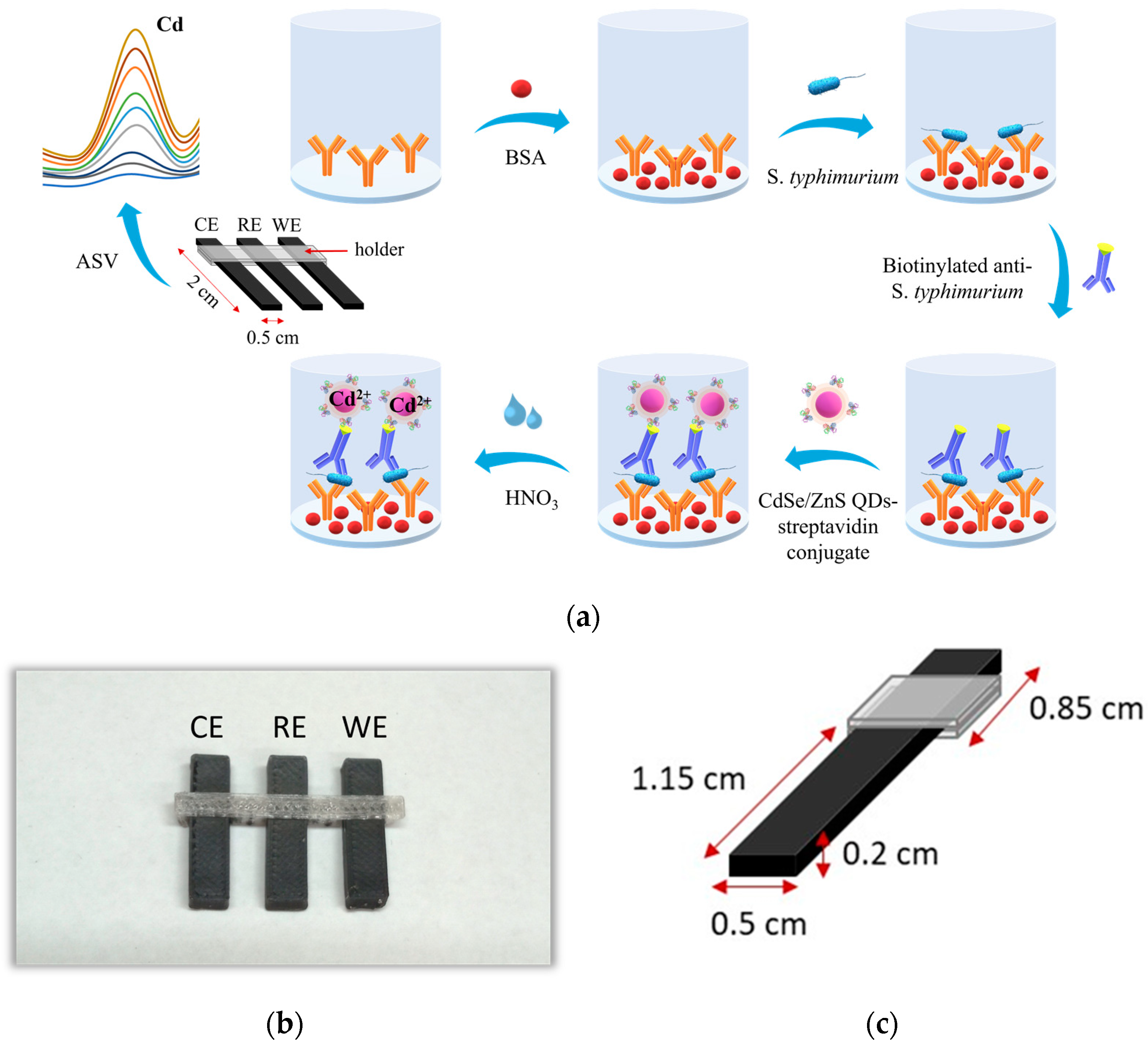

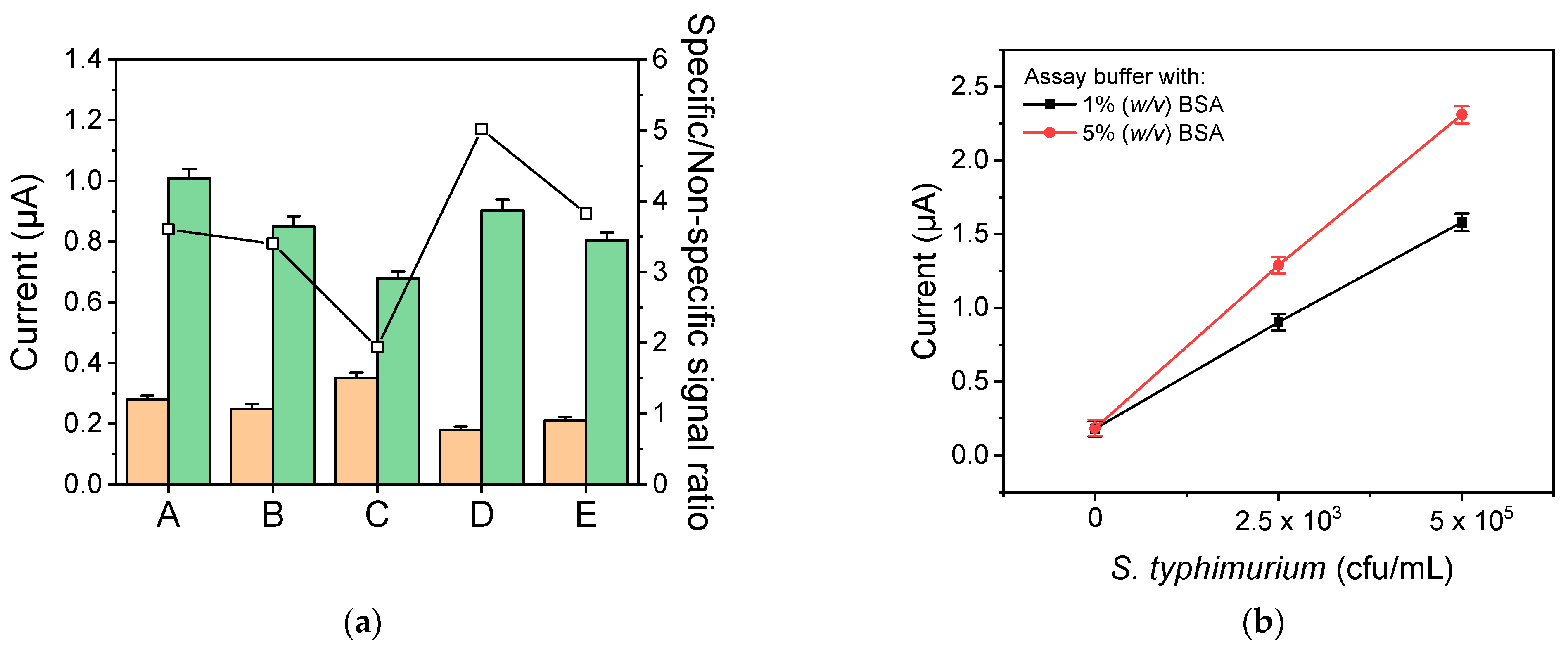
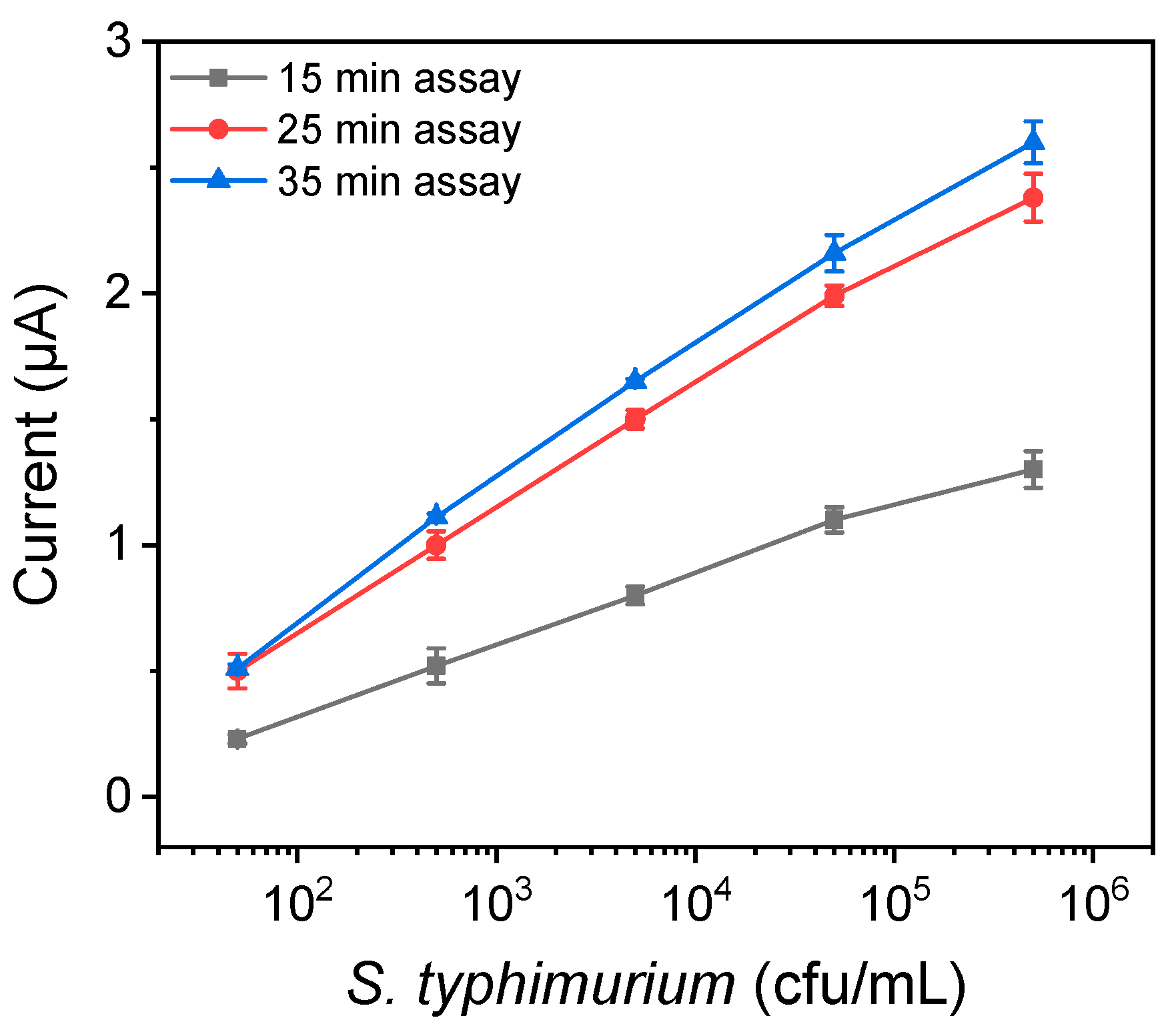
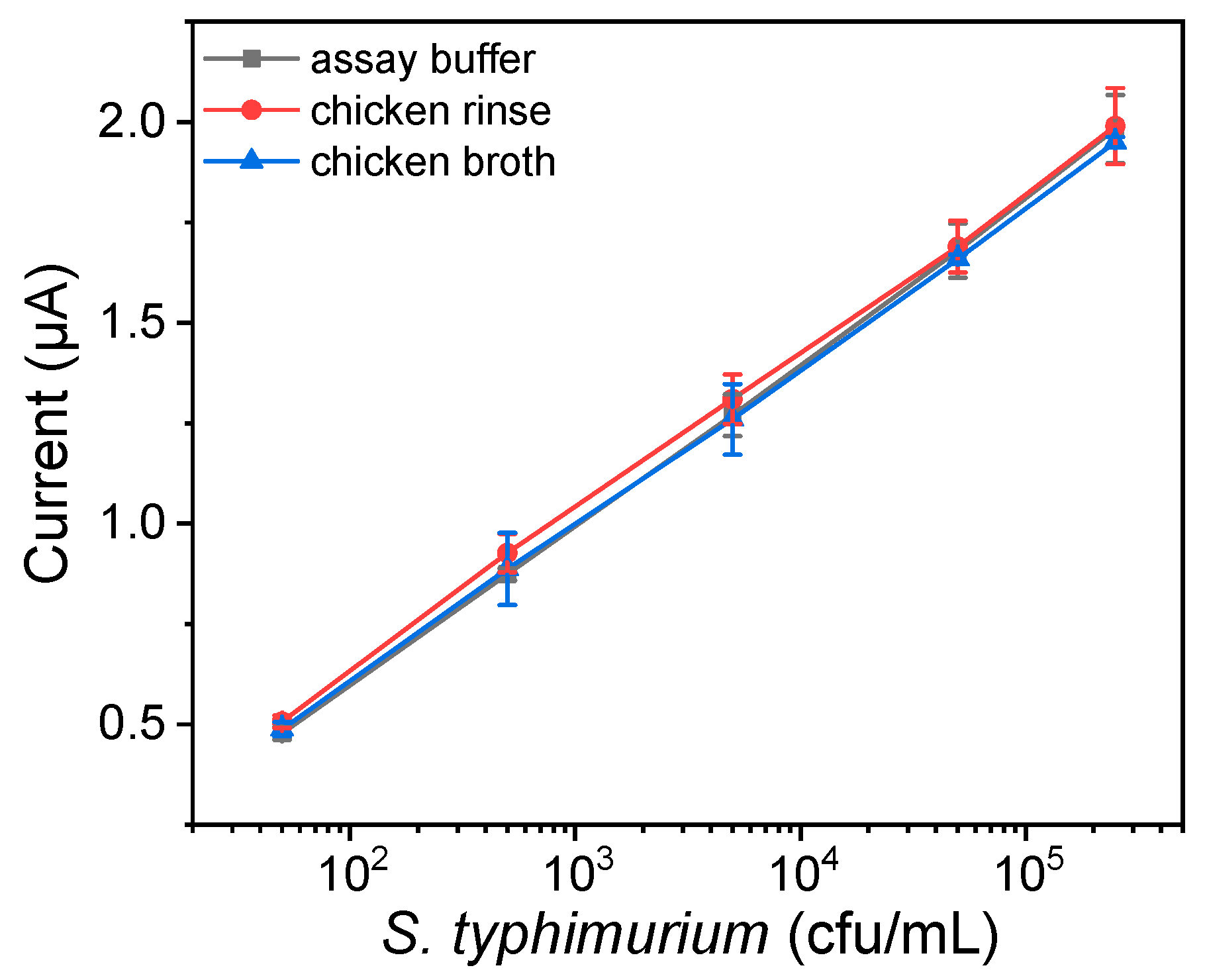
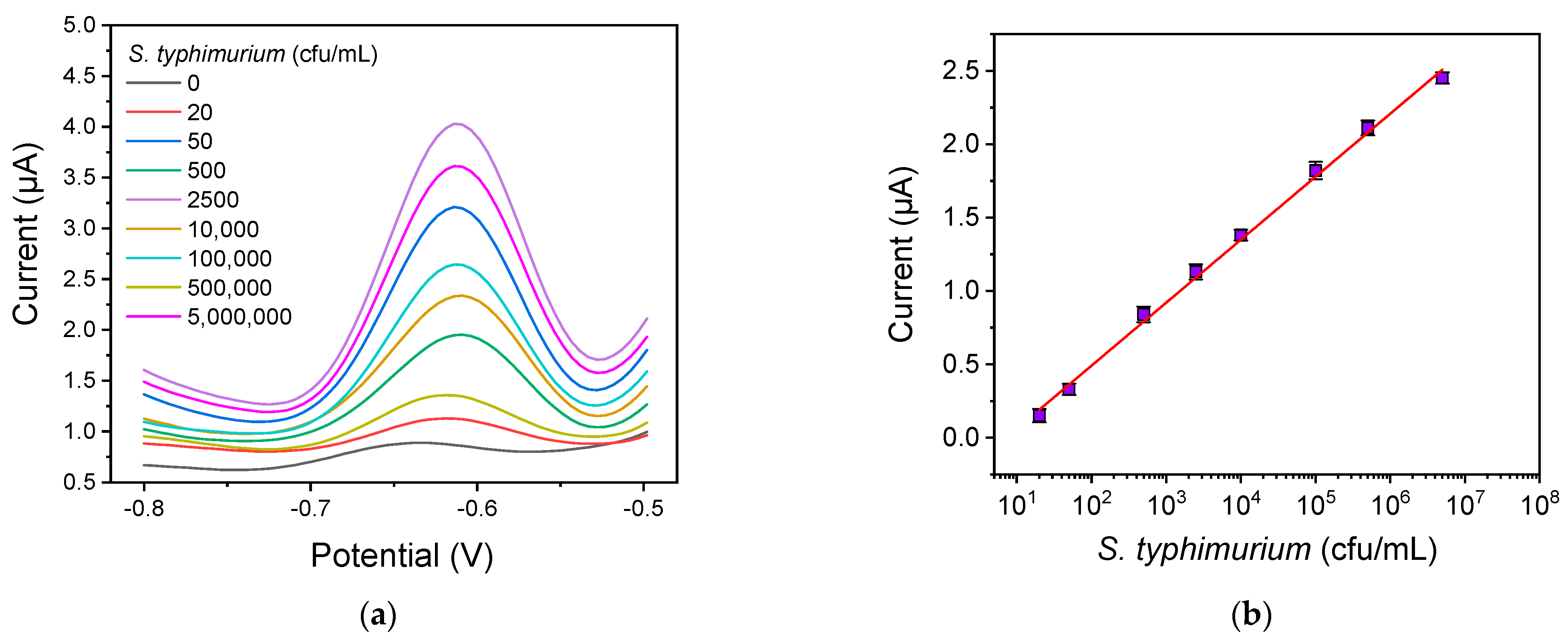
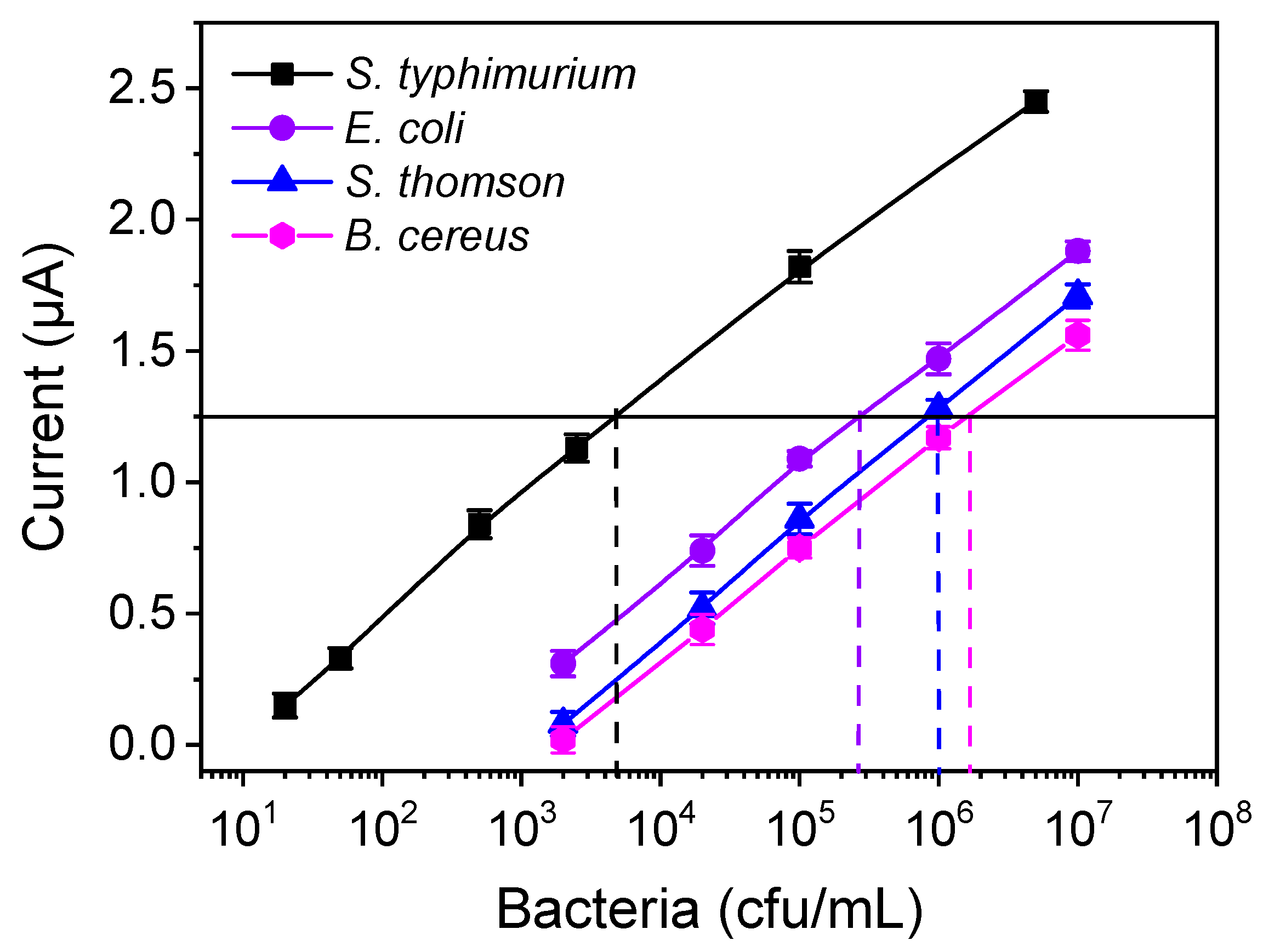
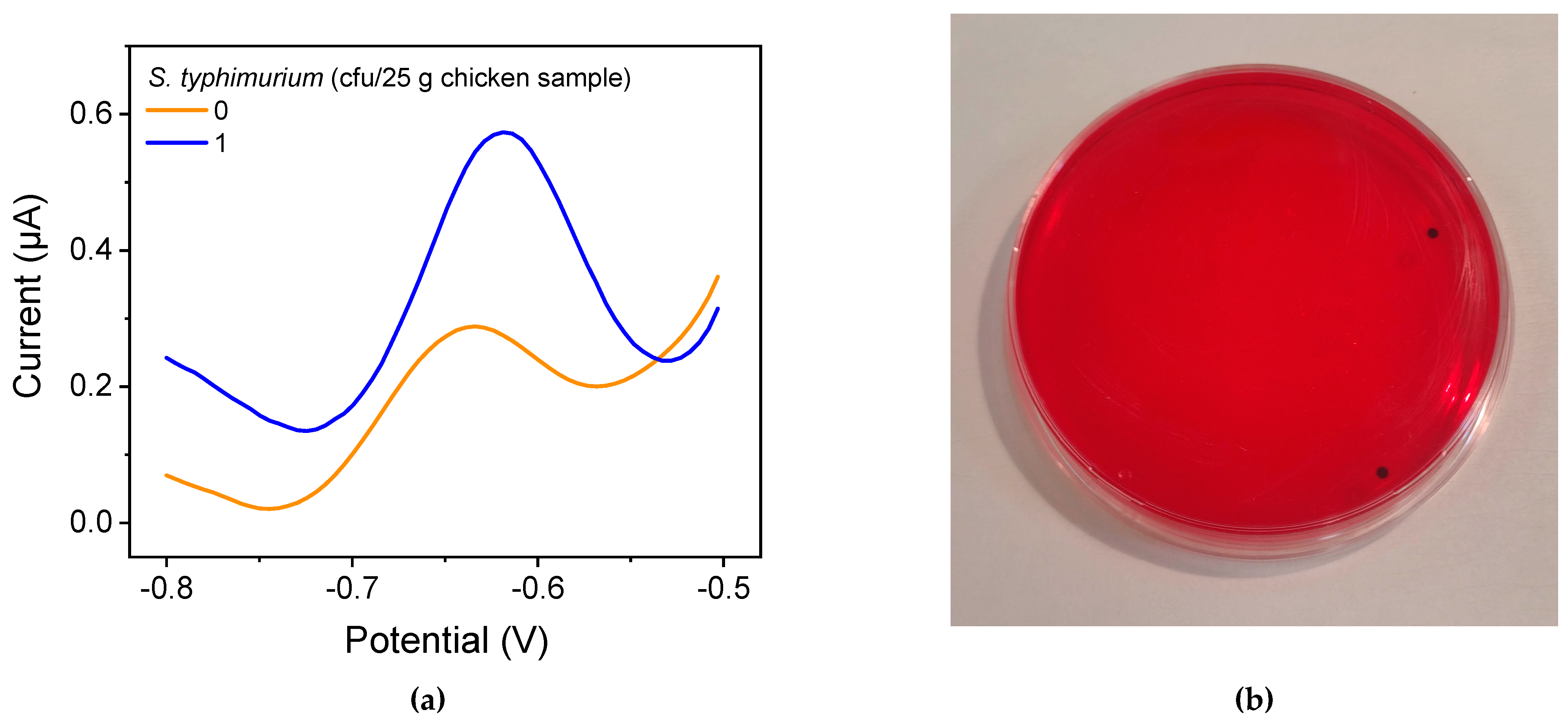
| Sample | Amount Added (cfu/mL) | Amount Determined (cfu/mL) | %Recovery |
|---|---|---|---|
| Chicken broth (Mimikos) | 3 × 101 | 3.2 ± 0.2 × 101 | 107 ± 6.2 |
| 3 × 103 | 2.9 ± 0.1 × 103 | 96.7 ± 3.4 | |
| 3 × 105 | 2.8 ± 0.2 × 105 | 93.3 ± 7.1 | |
| Chicken rinse (Mimikos) | 3 × 101 | 3.1 ± 0.1 × 101 | 103 ± 3.2 |
| 3 × 103 | 2.9 ± 0.3 × 103 | 96.7 ± 10.3 | |
| 3 × 105 | 3.3 ± 0.2 × 105 | 110 ± 6.1 | |
| Chicken broth (Nitsiakos) | 3 × 101 | 3.4 ± 0.2 × 101 | 113 ± 5.9 |
| 3 × 103 | 3.3 ± 0.1 × 103 | 110 ± 3.0 | |
| 3 × 105 | 2.9 ± 0.2 × 105 | 96.7 ± 6.9 | |
| Chicken rinse (Nitsiakos) | 3 × 101 | 2.8 ± 0.3 × 101 | 93.3 ± 10.7 |
| 3 × 103 | 2.9 ± 0.1 × 103 | 96.7 ± 3.4 | |
| 3 × 105 | 3.2 ± 0.2 × 105 | 107 ± 6.2 |
| Detection Method | Matrix | Time (Min) | Dynamic Range (cfu/mL) | LOD (cfu/mL) | Ref. |
|---|---|---|---|---|---|
| DPV | Milk | 90 | 10–107 | 3 | [16] |
| DPV | 1/10 diluted milk | 90 * | 2.4 × 102–2.4 107 | 2.4 × 102 | [17] |
| Magneto-electrode/ amperometry | 1/10 diluted milk in LB broth | 50 | 7.5 × 103–105 | 7.5 × 103 | [22] |
| EIS | Milk | 60 | 5 × 102–105 | 5 × 102 | [20] |
| EIS | Milk | 20 | 103–108 | 1 × 103 | [32] |
| EIS | Buffer | 42 | 101–107 | 10 | [33] |
| Interdigitated array microelectrodes/Impedance | PBS | 30 | 103–107 | 1 × 103 | [34] |
| Potentiometry | Milk | 75 | 2 × 101–108 | 20 | [35] |
| Chronoamperometry | Raw, whole, and skimmed milk | 125 | 101–105 | 10 | [36] |
| Chronoamperometry | Whole and skimmed milk | 125 | 101–106 | 10 | [37] |
| Potentiometry | 1/10 diluted apple juice | <60 | 101–105 | 5 | [38] |
| Potentiometry | 1/10 diluted apple juice | 60 | 101–106 | 6 | [18] |
| Interdigitated microelectrodes/Impedance | Chicken rinse water | <120 | 103–106 | 103 | [19] |
| Chronoamperometry | Chicken meat | 120 | 2 × 101–107 | ~20 | [21] |
| Impedance | Ready to ear turkey | 60 | 3 × 102–103 | 3 × 102 | [4] |
| EIS | Chicken broth | 22 | 25–105 | 13 ± 7 | [31] |
| ASV | Chicken broth and chicken rinse | 25 | 101–5 × 106 | 5 | This work |
Disclaimer/Publisher’s Note: The statements, opinions and data contained in all publications are solely those of the individual author(s) and contributor(s) and not of MDPI and/or the editor(s). MDPI and/or the editor(s) disclaim responsibility for any injury to people or property resulting from any ideas, methods, instructions or products referred to in the content. |
© 2023 by the authors. Licensee MDPI, Basel, Switzerland. This article is an open access article distributed under the terms and conditions of the Creative Commons Attribution (CC BY) license (https://creativecommons.org/licenses/by/4.0/).
Share and Cite
Angelopoulou, M.; Kourti, D.; Mertiri, M.; Petrou, P.; Kakabakos, S.; Kokkinos, C. A 3D-Printed Electrochemical Immunosensor Employing Cd/Se ZnS QDs as Labels for the Rapid and Ultrasensitive Detection of Salmonella typhimurium in Poultry Samples. Chemosensors 2023, 11, 475. https://doi.org/10.3390/chemosensors11090475
Angelopoulou M, Kourti D, Mertiri M, Petrou P, Kakabakos S, Kokkinos C. A 3D-Printed Electrochemical Immunosensor Employing Cd/Se ZnS QDs as Labels for the Rapid and Ultrasensitive Detection of Salmonella typhimurium in Poultry Samples. Chemosensors. 2023; 11(9):475. https://doi.org/10.3390/chemosensors11090475
Chicago/Turabian StyleAngelopoulou, Michailia, Dimitra Kourti, Maria Mertiri, Panagiota Petrou, Sotirios Kakabakos, and Christos Kokkinos. 2023. "A 3D-Printed Electrochemical Immunosensor Employing Cd/Se ZnS QDs as Labels for the Rapid and Ultrasensitive Detection of Salmonella typhimurium in Poultry Samples" Chemosensors 11, no. 9: 475. https://doi.org/10.3390/chemosensors11090475
APA StyleAngelopoulou, M., Kourti, D., Mertiri, M., Petrou, P., Kakabakos, S., & Kokkinos, C. (2023). A 3D-Printed Electrochemical Immunosensor Employing Cd/Se ZnS QDs as Labels for the Rapid and Ultrasensitive Detection of Salmonella typhimurium in Poultry Samples. Chemosensors, 11(9), 475. https://doi.org/10.3390/chemosensors11090475











